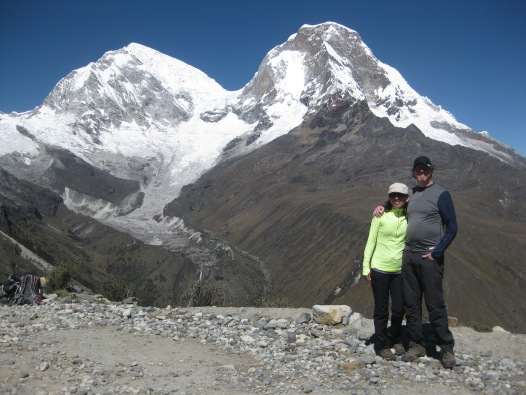The Santa Cruz Trek: Logistics and Planning
What about me? Can I do the Santa Cruz Trek?

This is what you may be asking yourself. The scenery looks great, sure, but can I do it? How hard it is really?
If you are an experienced hiker with lot of time spent at high altitude the answer is an emphatic yes, you can. Santa Cruz is considered, by the standards of multi-day treks in high alpine areas, to be relatively modest. Nevertheless, it is a formidable challenge and cannot be dismissed lightly.
If you are a less experienced hiker, and particularly if you have little or no experience at high altitude (above 10,000 feet) there many things to consider before you decide. Most hikers probably can do this trek, particularly if they opt to go as part of a guided expedition (which we definitely recommend for the casual hiker.) But you must aware of the many challenges that you will face on this trip, and particularly the great challenge of altitude sickness when you attempt to cross Punta Union.
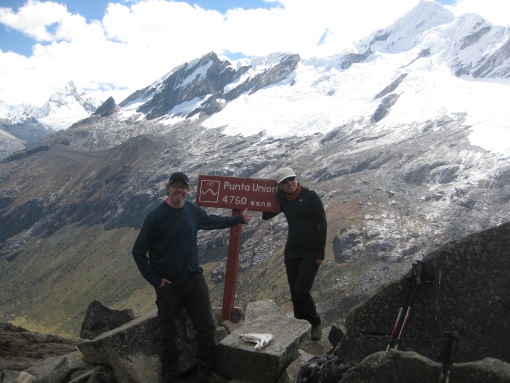
The entire trek basically boils down to Punta Union, in our opinion. Other than the one pass, the grades aren’t terribly steep, the trail is not unusually difficult in most places (though it has some rough areas) and at just four days in length – and half of that all downhill – it’s not especially long. If you can make it through this one pass, then you can probably do the rest with no problem at all.

Highlights:
- One of the Best Hikes in Peru
- In our opinion, the natural beauty of this trip blows away the Inca Trail
- Incredible high Alpine scenery, especially the middle two days
- View from Punta Union beyond description
- Recommended to all fit hikers who can tolerate high elevation
- Best time to go is the dry season, May to September
- Very good chance of good weather if done in season, especially July and August
- We hiked in early July and had nothing but clear weather
- See some of the biggest mountains in South America (and outside of the Himalaya, in the world!)
- 22,000 foot Nevado Huascaran, Peru’s highest mountain
- Other notable peaks include Pisco, Chacraraju, Artesonraju, Alpamayo and of course Nevado Santa Cruz
- Eye level views of impressive glaciers
- Turquoise mountain lakes
- Weird UFO-like cloud effects over the peaks almost every morning
- See (and walk through) the astounding aftermath of a HUGE avalanche
- Other than Punta Union, no major obstacles along this trail
- Many guided options available out of Huaraz
- Huaraz itself, perhaps the best hiking town in South America, is well worth seeing
- Take a day to see Pastoruri Glacier
- Generally safe; robberies not an issue
- Almost no road walking
- Horses can be rented in a ‘contingency’
- Hiring guides is easy and affordable
- Generally speaking, Peru is not expensive, though it has become more expensive lately
- No technical equipment or training is required, you just walk
- If you go with a guided hike, meals and much of the gear is provided
- This can be (and often is) attempted independently
- If this isn’t enough for you consider the Alpamayo Trek or, if you are REALLY hardcore, the Huayhuash Circuit
Considerations:
- Altitude is a serious consideration here
- 2-3 days of acclimatizing in Huaraz recommended
- Altitude affects people differently; even fit people can be wiped out by it
- Hard to know how altitude will impact you until it does
- 15,000+ ft Pass of Punta Union is higher than most Gringos will ever go
- We saw a LOT of young hikers utterly destroyed by the pass
- Minimum three days; four recommended
- Most do this in the clockwise direction, leaving from Cashapampa and returning via Vaqueria (we would advise considering the opposite)
- No Incan Ruins on this trek (See Inca Trail)
- The trails go through some fairly remote areas
- No towns, stores, roads or easy ways of bailing out
- In 2015 there were NO working bathrooms en route
- Despite what many trip reports say, there was no opportunity to purchase supplies except near the very beginning and end (exactly where you won’t need them in other words.)
- Strongly recommend water treatment tablets or filtration system
- The valleys are HEAVILY grazed by cattle and other domestic livestock
- If you don’t like being around large quantities of animal dung, this may not be your hike
- Expect cold (sometimes below freezing) mornings
- If you tent, remember you must lug your supplies over Punta Union
- On guided tours, it is sometimes difficult to figure out in advance what the guides will and won’t do, and what the exact itinerary will be
- Conversational Spain-talk necessary if you chose to go independent
- The drive in and out, while spectacular, is long and quite hair raising at times
- Biting flies are legion in the lower campgrounds
- With all that said above about how great the weather is, I have read many trip reports where Punta Union was completely socked in, which would really suck.
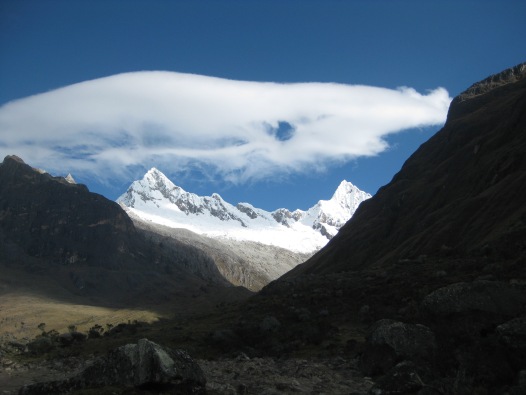
Before you go
Sylvia and I did this trip with a guide agency in 2015. A guide, cook, meals, tents and mules were provided (the mules carried the gear, not us.) Unlike our 2011 Salkantay Trek, we were NOT part of a tour group; these guides were hired for us alone. While being part of a group is fun, having our own private guides certainly had advantages too, one of which being that we went at our own pace (as opposed to Salkantay where we were continually, if gently, hurried along.) Our guide, Freddie, was attentive and knowledgeable. We would go the guided route again at Colca Canyon and Misti in 2017.
It is NOT necessary to hire a guide; you could do this trip entirely on your own if you chose. This option is recommended only to very experienced and self-sufficient hikers. Note that Santa Cruz is much more difficult to do independently than most of the Inca Trail options or Colca Canyon, because there are no re-supply or lodging options available.

We did the trip in the opposite direction that most do it; IE, counter-clockwise. This was a decision made by the guides, and we can’t fault them for it. In fact, while I would stop short of actually advising you do it this way, it did have some serious advantages. It saves the million-dollar view from Punta Union until the moment you burst through the pass, for one thing, and while the downhill beyond the pass was steep in many places, I could only imagine what a slog it would be coming up it. If you have NOT yet acclimated, this might be the better way to do it, because it saves the pass for the third day (we crossed on the second.)
Most start in Cashapampa coming in via the town of Caraz, and leave via Vaqueria and the town of Yunguay. We did the reverse; we went up, rather than down, the dramatic Portachuelo de Llanganuco. It seemed no less impressive on the way up.
I would also strongly advise taking a side detour to view the Alpamayo from a position of advantage if you can. Again, the counter clockwise direction may help with this, because you would do it at the beginning of the third day with the pass behind you and the rest all downhill. If you do it going the other direction, it adds to the climbing.
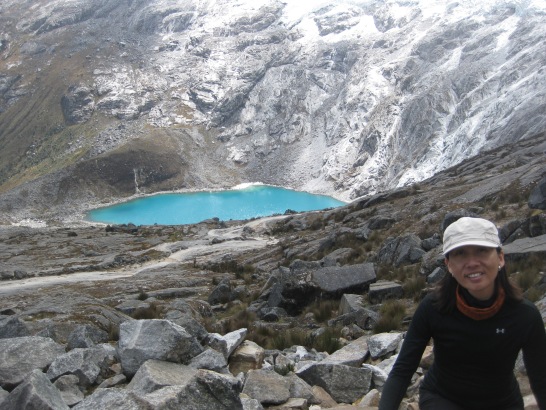
If you want more information about independent trekking, the best places to start are the hiking blogs of Cam Honan and Rick McCharles, who have vast resources devoted to independent hiking.
What Do I Need To Bring?
The following items are mandatory:
- Rain Gear
- Good boots or shoes
- Hydration system
- Pack (doesn’t have to be a full multi-day pack)
- Extra warm layers, including gloves and hat
- Sleeping bag (carry one even if the tour company says they provide one)
- Water purification system
The following items are NOT mandatory, but are advisable:
- Sleeping pad (Even if the tour company says they provide one, two won’t hurt)
- Snacks
- First aid gear (especially some sort of aspirin or ibuprofen)
- Camera/phone
- Charger for above
- Something for the altitude
If you go with a tour, leave the following at home:
- Tent
- Stove
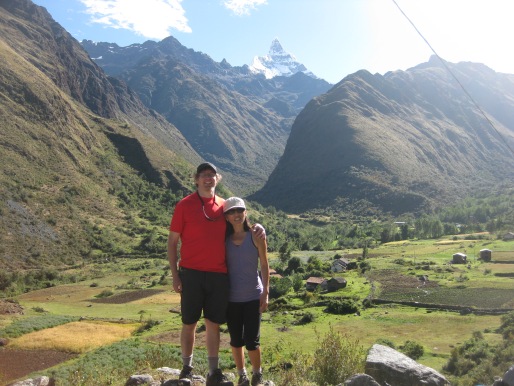
Note that in 2015 Brian and Sylvia hiked without a proper water purification system; we were forced to rely on the guides to help boil water for us. This was a major oversight on someone’s part. There are very few reliable water sources along the route (none I would advice a Gringo drink from.) Unlike other long distance hikes we have done in Peru, there were NO stores or merchants along the Santa Cruz Trek for the majority of the way. Thus, be prepared to filter your own water.
A note on snacks…we brought a goodly number of them, but our guides also provided us a whole ton of snacks along the way…so many in fact that we ended the hike with more snacks than we started with. We easily could have ditched every snack we carried and used extra space saved for a water filtration system. As always, it is VERY useful to know in advance what will and won’t be provided by your guides if you go that route.
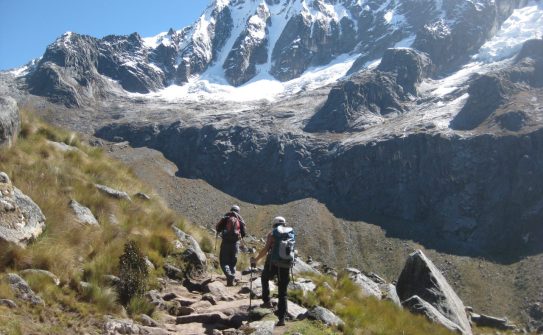
Which brings us to the final item about gear… In every adventure we have planned in Peru, there has been some degree of disconnect between what the tour company told us via phone/email and what the guides told us once we were on the trail. Sometimes we were pleasantly surprised; other times, the surprises were less pleasant. Try to find out what, exactly the guides will be doing for you and what they won’t. Will they be providing ALL meals or just dinner? How about snacks? Will you have tents, or tents with sleeping pads, etc? Can any gear be sent ahead on the horses? And then of course, you must factor in that anything the tour company tells you may in fact be completely wrong.
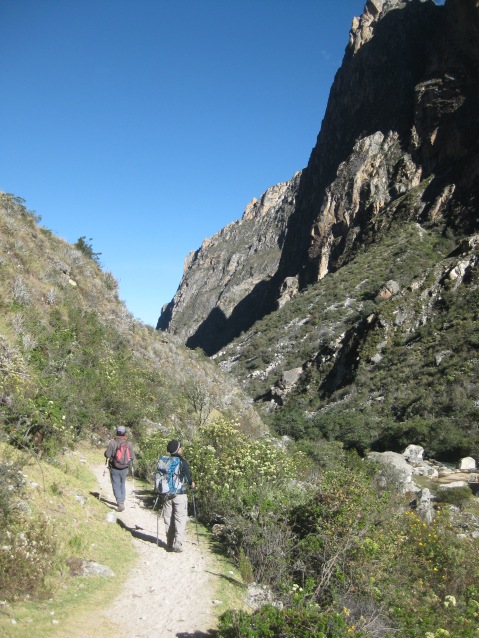
How can I get ready?
Do as much hiking as you can. If it is possible, try to do as much acclimatization as possible at high altitude. Note that for most of the people reading this, the previous sentence translates into “the impossible.” There is no high-altitude hiking to be had east of the Rockies, so for three quarters of the US and lower Canada, that’s a non-starter. If you live in the UK or Ireland or Australia…same applies. You will need to do as much aerobic exercise and walking as possible, preferably off-trail with a pack of 15-20 pounds.
In the specific case of the Santa Cruz Trek, Brian had no problem with the elevation and Sylvia did. This was an exact reversal of the situation in 2011 when we did Salkantay. Again, tolerance of high elevation is a very difficult thing to gauge in a person. Fit people are generally better prepared for it than unfit people, but even that isn’t always the case. Sylvia and I had approximately the same level of fitness going into SCT; hers was perhaps even better, because thanks to his ‘trick knee’ Brian a-cain’t run no more. yet she struggled far more than I did.

The best thing you can do to improve you chances is, arrive in Huaraz a few days early and do as much walking as possible. Sylvia and I did the tour trip to Pastoruri (nearly 17,000 feet.) It proved to be less than what Sylvia needed but…still, she made it.
Finally, I would recommend you be able to speak at least passable Spanish. Sylvia of course is fluent in the Spain-Talk, being from Peru. Brian meanwhile is confined to Tarzan Spanish; he is working on improve this. Our guide on the Santa Cruz Hike, Freddie, spoke more than passable English (as most guides do) but it greatly helps to know what the hell is going on around you. Needless to say, I would not do this hike independently unless I could speak the local language.

The Santa Cruz Trek is a unique and once in a lifetime experience that is worth trying for. Unlike Machu Picchu you can NOT see this from a bus…this has to be walked, and the things you will experience are well worth the effort. Prepare as much as possible and be ready to deal with what comes up along the way. I believe that with some preparation, proper conditioning and the proper attitude, most able bodied people will be able to do this trek and will love it.
Interested? What are you waiting for? It’s there. Right now…it’s there.
